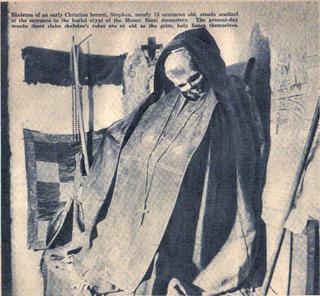Guess who's coming to dinner?

Skeleton of an early Christian hermit, Stephen, nearly 15 centuries old, stands sentinel at the entrance to the burial crypt of the Mount Sinai monastery. The present-day monks there claim the skeleton's robes are as old as the grim, holy bones themselves.

Gaping skulls, stored in the crypt, are those of countless monks long dead. Monks are buried in the churchyard for seven years, then disinterred.
Pious reminders of death surround devoted recluses who serve God in Sinai's remote monastery.
Among the barren desert ravines at the foot of Christendom's most sacred mountain - Mount Sinai, in Egypt - lies an ancient and most famous monastery. Here, in splendid isolation, a small community of monks guard precious manuscripts recording the earliest annals of Christianity.
Mount Sinai was the place where, we are taught, the tablets setting out the Ten Commandments were revealed to Moses. In the mount Sinai Library, incongruously modern in the 6th century stone setting of the monastery, the 20th centuryhas at last intruded fully. An American expedition is there now, photographing all the Library's rare documents.
(From Australian Pix Magazine, June 12, 1954)

The monastery in the photographs is St Catherine's Monastery, also called the Monastery of the Transfiguration. The monastery has survived the religious upheavals in the Middle East because of a document in its possession, written by Mohammed, the founder of Islam, guaranteeing protection for the monastery.
The library collection of ancient manuscripts and codexes is second only to the Vatican.
Visit the monastery at http://www.geographia.com/egypt/sinai/stcatherine.html

1 Comments:
This is right at home here!
Post a Comment
<< Home